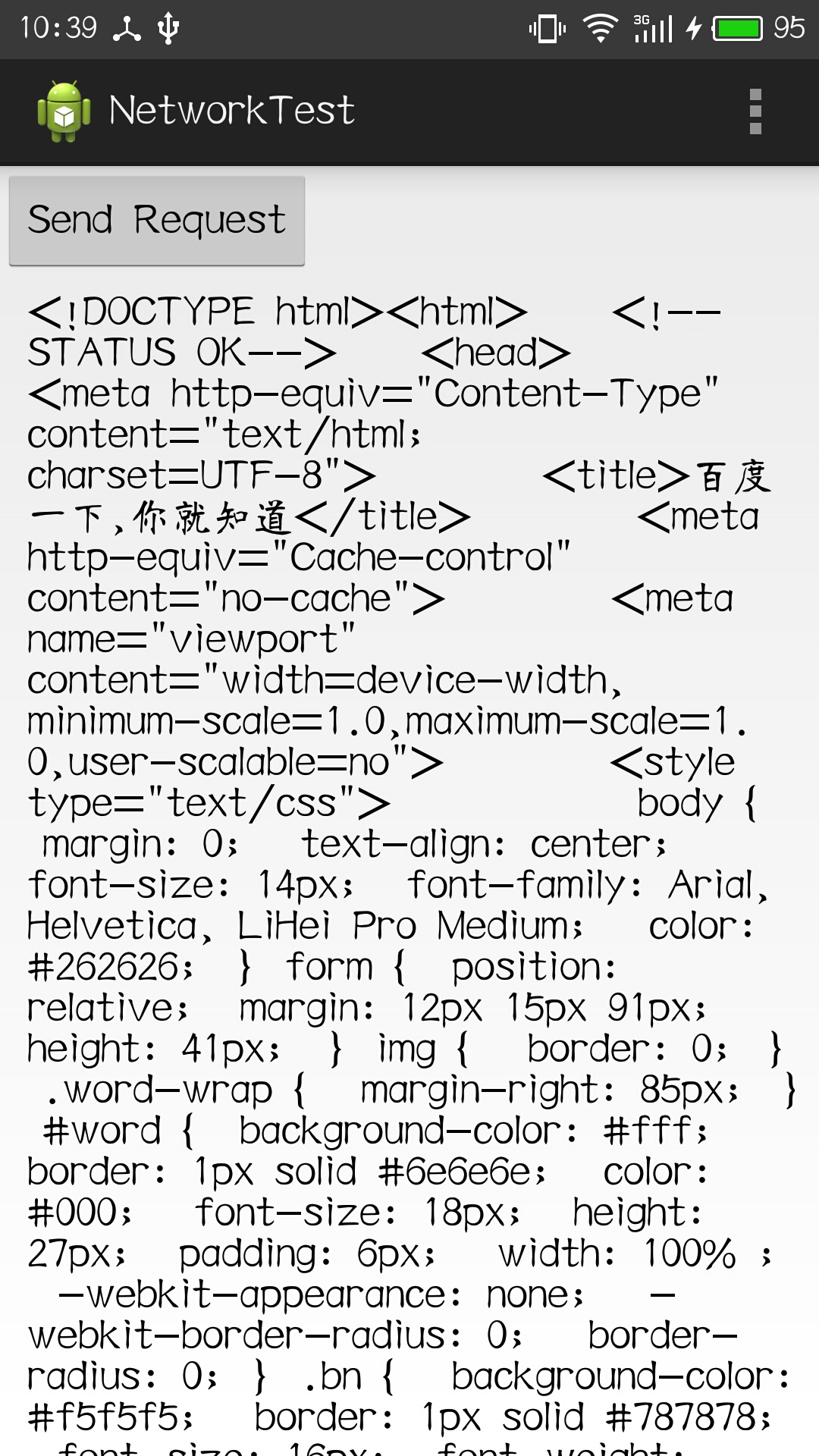Android基础总结(9)——网络技术
这里主要讲的是如何在手机端使用HTTP协议和服务器端进行网络交互,并对服务器返回的数据进行解析,这也是Android最常使用到的网络技术了。
1、WebView的用法
Android提供的WebView控件可以帮助我们在自己的应用程序中嵌入一个浏览器,从而非常轻松的展示各种各样的网页。下面是一个简单的示例:
1 <?xml version="1.0" encoding="utf-8"?> 2 <LinearLayout xmlns:android="http://schemas.android.com/apk/res/android" 3 android:layout_width="match_parent" 4 android:layout_height="match_parent" 5 android:orientation="vertical" > 6 7 <WebView 8 android:id="@+id/webView" 9 android:layout_width="match_parent" 10 android:layout_height="match_parent" /> 11 12 </LinearLayout>
1 public class MainActivity extends Activity { 2 3 private WebView webView ; 4 5 @Override 6 protected void onCreate(Bundle savedInstanceState) { 7 super.onCreate(savedInstanceState); 8 setContentView(R.layout.web_view); 9 10 webView = (WebView) findViewById(R.layout.web_view) ; 11 //调用getSettings()方法可以去设置浏览器的属性,我们这里只是调用 12 //setJavaScriptEnabled(true)方法来设置WebView支持TavaScript脚本 13 webView.getSettings().setJavaScriptEnabled(true); 14 /* 15 * 调用setWebViewClient()时我们传入了一个WebViewClient对象 16 * 这样做的功能是当需要从一个网页跳转到另一个网页时,我们希望目标 17 * 网页仍然在当前网页上显示,而不是打开系统浏览器 18 */ 19 webView.setWebViewClient(new WebViewClient()); 20 webView.loadUrl("http://www.baidu.com"); 21 } 22 }
2、使用HttpURLConnection访问网络
使用HttpURLConnection访问网络的方式很简单,具体按以下步骤执行就可以了:
- 获取HttpURLConnection对象,一般我们只需要new一个URL对象,并传入目标网络地址,然后调用一下openConnection()方法即可
1 URL url = new URL("http://www.baidu.com") ; 2 HttpURLConnection con = (HttpURLConnection) url.openConnection() ;
- 获取HttpURLConnection对象之后,设置HTTP请求所使用的方法。常用的方法有两种:GET或POST。GET表示希望从服务器那里获取数据,POST则表示希望提交数据给服务器。
1 con.setRequestMethod("GET"); - 接下来可以进行一些自由的设置,比如设置连接超时、读取超时的毫秒数,以及服务器希望得到的一些消息头等
1 con.setConnectTimeout(8000); 2 con.setReadTimeout(8000);
- 之后我们调用getInputStream()方法得到从服务器返回的输入流,然后从里面读取数据。注意,服务器返回给我们的HTML代码
1 InputStream in = con.getInputStream() ; 2 BufferedReader reader = new BufferedReader(new InputStreamReader(in)) ; 3 StringBuilder response = new StringBuilder() ; 4 String line ; 5 while((line = reader.readLine()) != null){ 6 response.append(line) ; 7 }
- 最后,使用完之后,我们要记得关闭连接资源
1 con.disconnect();
- 获取HttpURLConnection对象,一般我们只需要new一个URL对象,并传入目标网络地址,然后调用一下openConnection()方法即可
下面的代码是在界面上设置了一个按钮和一个编辑框,通过点击按钮,手机访问“http://www.baidu.com”网页,并将返回的数据显示在文本框中。布局代码如下:
1 <?xml version="1.0" encoding="utf-8"?> 2 <LinearLayout xmlns:android="http://schemas.android.com/apk/res/android" 3 android:layout_width="match_parent" 4 android:layout_height="match_parent" 5 android:orientation="vertical" > 6 7 <Button 8 android:id="@+id/button" 9 android:layout_width="wrap_content" 10 android:layout_height="wrap_content" 11 android:text="Send Request" /> 12 13 <ScrollView 14 android:id="@+id/scrollView" 15 android:layout_width="match_parent" 16 android:layout_height="match_parent" 17 android:layout_weight="0.61" >
19 <EditText 20 android:id="@+id/response_text" 21 android:layout_width="match_parent" 22 android:layout_height="wrap_content" 23 android:ems="10" 24 android:inputType="textMultiLine" > 27 </EditText> 28 </ScrollView> 29 </LinearLayout>
Activity代码如下:
1 public class MainActivity extends Activity implements OnClickListener{ 2 3 private static final int SHOW_RESPONSE = 0 ; 4 private Button sendResquest ; 5 private EditText responseText ; 6 7 private Handler handler = new Handler(){ 8 @Override 9 public void handleMessage(Message msg) { 10 switch(msg.what){ 11 case SHOW_RESPONSE : 12 String response = (String)msg.obj ; 13 //显示结果 14 responseText.setText(response); 15 } 16 } 18 } ; 19 20 @Override 21 protected void onCreate(Bundle savedInstanceState) { 22 super.onCreate(savedInstanceState); 23 setContentView(R.layout.my_layout); 24 25 sendResquest = (Button) findViewById(R.id.button) ; 26 responseText = (EditText) findViewById(R.id.response_text) ; 27 sendResquest.setOnClickListener(this) ; 28 } 29 30 @Override 31 public void onClick(View v) { 32 if(v.getId() == R.id.button){ 33 sendRequestWithHttpURLConnection() ; 34 } 35 } 36 37 private void sendRequestWithHttpURLConnection() { 38 //开启线程发起网络 39 new Thread(new Runnable(){ 40 41 @Override 42 public void run() { 43 HttpURLConnection con = null ; 44 try { 45 URL url = new URL("http://www.baidu.com") ; 46 con = (HttpURLConnection) url.openConnection() ; 47 con.setRequestMethod("GET"); 48 con.setConnectTimeout(8000); 49 con.setReadTimeout(8000); 50 InputStream in = con.getInputStream() ; 51 BufferedReader reader = new BufferedReader(new InputStreamReader(in)) ; 52 StringBuilder response = new StringBuilder() ; 53 String line ; 54 while((line = reader.readLine()) != null){ 55 response.append(line) ; 56 } 57 58 Message msg = new Message() ; 59 msg.what = SHOW_RESPONSE ; 60 msg.obj = response.toString() ; 61 handler.sendMessage(msg) ; 62 63 } catch (IOException e) { 64 // TODO Auto-generated catch block 65 e.printStackTrace(); 66 }finally{ 67 if(con != null){ 68 con.disconnect(); 69 } 70 } 71 } 72 }).start(); 73 } 75 }

3、使用HttpClient
访问网络,除了用上面的HttpURLConnection之外,我们还可以用HttpClient来访问http网页资源。HttpClient可以完成过和HttpURLConnection几乎一模一样的功能。具体用法如下:
- 获取HttpClient的实例,但是HttpClient是一个接口,我们通常是创建一个DefaultHttpClient对象
1 HttpClient httpClient = new DefaultHttpClient() ;
- 接下来如果要发起一条GET请求,则我们需要创建一个HttpGet对象,并传入目标网络的地址,然后调用HttpClient的execute()方法就可以获得服务器的响应HttpResponse 对象
1 HttpGet httpGet = new HttpGet("http://www.baidu.com") ; 2 HttpResponse httpResponse = httpClient.execute(httpGet) ;
如果是要发起一条POST请求,我们需要和创建一个HttpPost对象,并传入目标网络地址,然后通过一个NameValuePair集合来存放待提交的参数,并将这个参数集合传入UrlEncodedFormEntity中,然后调用HttpPost的setEntity()方法将构建好的UrlEncodedFormEntity传入,然后调用HttpClient的execute()方法就可以获得服务器的响应HttpResponse 对象
1 HttpPost httpPost = new HttpPost("http://www.baidu.com") ; 2 List<NameValuePair> params = new ArrayList<NameValuePair>() ; 3 params.add(new BasicNameValuePair("username","admin")) ; 4 params.add(new BasicNameValuePair("password","123456")) ; 5 UrlEncodedFormEntity entity = new UrlEncodedFormEntity(params,"utf-8"); 6 httpPost.setEntity(entity);
HttpResponse httpResponse = httpClient.execute(httpPost) ; - 得到HttpResponse 对象之后,服务器所返回的信息就全部都包含在这里了。通常情况下我们都会先取出服务器返回的状态码,如果等于200就说明请求和相应都成功了,然后我们就提取HttpEntity实例,然后将这个实例转化为String即可
1 if(httpResponse.getStatusLine().getStatusCode() == 200){ 2 //请求和相应都成功了 3 HttpEntity entity = httpResponse.getEntity() ; 4 String response = EntityUtils.toString(entity,"utf-8") ; 5 6 Message msg = new Message() ; 7 msg.what = SHOW_RESPONSE ; 8 msg.obj = response.toString() ; 9 handler.sendMessage(msg) ; 10 }
- 获取HttpClient的实例,但是HttpClient是一个接口,我们通常是创建一个DefaultHttpClient对象

